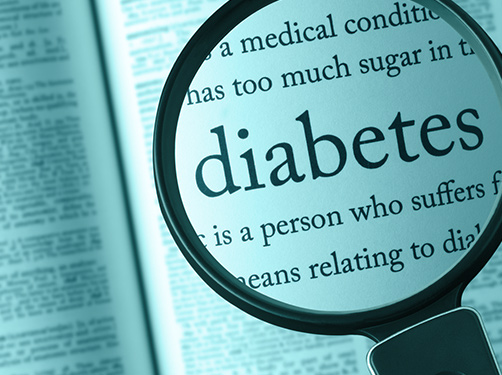What problems associated with type 1 diabetes can develop during puberty?
Scientific support: Dr. Katharina Warncke
The number of children and adolescents in Germany with type 1 diabetes is increasing. There are currently approx. 30,000 young people under the age of 20 with type 1 diabetes. For those affected and those close to them, it is a major challenge to live and grow up with the disease.
The often difficult period of puberty poses additional problems for the treatment of a chronic disease like type 1 diabetes. Diabetes also requires a high level of self-management for insulin injections, blood sugar levels testing, and carbohydrate calculations. This is an additional challenge during this phase of withdrawal, increased levels of self-responsibility, and detachment from parents. The disease does not allow for breaks in treatment. Furthermore, hormonal changes can lead to massive blood sugar level fluctuations.

Many affected teenagers have severe fluctuations in the metabolic state during this time. Various sources list the average long-term blood sugar value (HbA1c) of teenagers with type 1 diabetes as approx. 8.4 to 9.3 percent. Ideally, it should be between 6.5 and 7 percent. In the long term, continuously high blood sugar levels or poor management are associated with late-onset complications affecting the eyes, kidneys, nerves, and heart. For this reason, blood sugar fluctuations should definitely be avoided.
To help them achieve this, young people require good support from their diabetes team, which has ideally been involved in their treatment for several years. The team also understands the problems during puberty that can lead to metabolic imbalances.
Adolescents with diabetes should be made aware of the effects of alcohol. Severely low blood sugar levels (hypoglycemia) can occur several hours after drinking alcohol.
Because they cause insulin resistance, sex hormones increase the amount of insulin required. In girls, the hormone is estrogen and, in boys, it is testosterone. As a result, more insulin being required during puberty to help achieve good blood sugar management. This is compounded by the fact that both hormones circulate through the body in fluctuating concentrations. This also leads to fluctuating blood sugar levels.
Many girls notice this very clearly when they get their period. Around the middle of the menstrual cycle, the blood sugar can only be reduced by administering a higher dose of insulin. When the menstrual bleeding starts, the amount of insulin falls, increasing the risk of low blood sugar levels.
Another essential hormone produced in increased amounts during puberty is growth hormone. Along with other factors, it is responsible for the growth spurt experienced during this phase of life. This hormone also reduces the effects of insulin. This again results in blood sugar fluctuations.
Growth hormone is usually released in the morning and leads to high blood sugar levels when it is time to get up. This is known as the dawn phenomenon and can also affect adults. Here the hormone cortisol, growth hormone, and the sex hormones all play a role.
Growth hormone is not regularly released into the bloodstream. The most intense release of growth hormone takes place at the end of puberty in boys and at the start of puberty in girls. These are the most pronounced growth phases. However, this varies greatly from person to person During these phases, the insulin dose must be appropriately adjusted at night.
Simultaneously, remodeling processes take place in the brains of adolescents. During this time, there are excessive reactions in the regions of the brain responsible for stress perception and emotional states. Teenagers are less able to cope with stress and suffer massive mood swings within minutes. This can make it even more difficult to react calmly to fluctuating blood sugar levels. Adolescents may reject the disease and neglect treatment.
These hormonal changes cause the insulin requirement to increase during puberty: from approx. 1 insulin unit per kg of body weight per day to 1.5 insulin units per kg of body weight per day. Therefore, it is important to adjust the basic amount of insulin required (basal rate). This is the amount of insulin the body needs throughout the course of the day.
The basal rate is determined, adapted and monitored by the diabetic specialist. This enables insulin administration based in the individual needs of the patient. In particular, the high early morning blood sugar levels can be counteracted.
Due to the hormonal situation and the corresponding blood sugar level fluctuations, it is not easy for adolescents to achieve a good long-term blood sugar value (HbA1c). At the end of puberty, the metabolic state begins to calm down and the amount of insulin required begins to fall.
Some important tips for parents and young people:
- Regular and closely-scheduled appointments with the treating diabetologist are recommended. They can assess the insulin dosage, adjust it if necessary, or discuss special situations.
- Agree on rules and boundaries in order to support increasing independence, also in dealing with the illness, but do not leave it uncontrolled. It is not advisable to give adolescents sole responsibility for the management of diabetes too early.
- Make use of training opportunities offered by the diabetes team. These courses promote the self-management skills of young people and their family.
- Look for self-help groups. These groups can help people deal with the disease in a more confident and independent way.
Turning 18 is a time of transition. Transition describes the change of adolescents from pediatric diabetes care to adult diabetology.
This change is not always without problems and young people often lose their contact to their specialized treatment provider. This can result in an increase of the long-term blood sugar value (HbA1c) and acute complications, such as low blood sugar or metabolic imbalances. There are programs that help with the transition to adult treatments (Berliner TransitionsProgramm e. V., ModuS Transitionsschulung, Between-Kompas) (Link in German).
How can parents help motivate adolescents with type 1 diabetes to adhere to their treatment?
- Involve your child's circle of friends. Young people tend to listen to advice from their friends and take it more seriously.
- Use the digital support provided by smartphones. For example, smartphone apps offer blood sugar measurement systems or bolus calculators. Bolus refers to the amount of insulin needed to counteract the blood sugar increase after a meal or corrects levels that are acutely too high.
- Try to facilitate contact with people of the same age with diabetes. There are vacations and camps for adolescents with diabetes.
- Alongside your diabetes team, you and your child can find support in self-help groups, online forums, or special Facebook groups for parents of adolescents with diabetes.
Because young people can legally purchase beer, wine, or sparkling wine at age 16, teenagers with diabetes must be made aware of the effects of alcohol. Alcohol lowers blood sugar levels and can cause severely low blood sugar levels. It impairs the production of sugar in the liver (gluconeogenesis). Sugar (glucose) is stored in the liver in the form of glycogen. These reserves are continuously released into the blood to stop the blood sugar level falling too far. If the liver is focused on breaking down alcohol, it cannot provide the blood with sugar. There is a risk of low blood sugar levels.
Alcoholic drinks, such as beer, sweet wine, or, in particular, liqueurs, also contain carbohydrates. They cause the blood sugar to increase rapidly followed by an equally fast drop. The effects of alcohol on the blood sugar levels last for an extended period of time, which is why low blood sugar levels associated with alcohol often occur during sleep. For this reason, more frequent testing at night is needed. The situation can become critical when the young person is trying alcohol for the first time or secretly and doesn’t measure their blood sugar at night.
The glucagon injection, normally used in emergency cases with low blood sugar levels, is ineffective. The injection only mobilizes the release of sugar by the liver. However, this is blocked due to the consumption of alcohol. This why low blood sugar levels associated with alcohol consumption usually require an infusion containing sugar administered by an emergency doctor.
How can low blood sugar levels associated with alcohol be prevented?
A strict ban on alcohol makes as little sense as excessive consumption. Nevertheless, a few precautionary measures should be put in place, for example:
- Always consume a snack containing carbohydrates or eat a meal when drinking alcohol. Never drink on an empty stomach.
- Drinks like beer and wine contain sugar. The need not be included when calculating the insulin dose.
- It is advisable to increase the frequency of blood sugar level testing between meals. Keep dextrose and the measurement device close at hand.
- To ensure that low blood sugar levels are not misinterpreted as intoxication in the event of an emergency, a diabetes passport should be carried at all times and friends should made aware of the condition.
- Excessive alcohol consumption should be taboo, because it means that low blood sugar may not be identified or correctly handled in an emergency. If a young person does end up drinking too much alcohol, the parents should be informed so they can do the blood sugar testing during the night.
- The drop in blood sugar levels can be delayed. To prevent the nocturnal drop in blood sugar levels, it is advisable to eat a snack at night. Blood sugar levels should not be below 150 mg/dl before going to bed.
- It is strongly advised to make use of the advice and training offered by the diabetes team before drinking alcohol for the first time.
Adolescents with type 1 diabetes are more likely to have psychological illnesses, such as depression and eating disorders. Girls are more affected than boys. This causes diabetes management to be neglected and the risk of complications rises.
Some young people use low-dose insulin for weight loss. Deliberate underdosing of insulin is known as insulin purging. The low insulin level means that more sugar stays in the blood and is then excreted with the urine via the kidneys. This results in weight loss without any great effort, but falls far short of the aims of the diabetes treatment. Permanently elevated blood sugar levels cause complications to develop much earlier.
Also, the risk of ketoacidosis – a dangerous metabolic imbalance due to lack of insulin – is increased.
To prevent this, parents and doctors should pay attention to possible symptoms of depression or anxiety and eating disorders.
Adolescents with type 1 diabetes and their parents can find support in self-help groups or forums. Bellow we have compiled a list of useful addresses (Websites in German):
Self-help groups:
- Elterninitiative diabetischer Kinder und Jugendlicher e.V. (Parental initiative for diabetic children and adolescents)
- Verein SPATZ - Selbsthilfe für Kinder mit chronischer Stoffwechsel-, Hormon- oder Zuckererkrankung e.V. (SPATZ - Self-help for children with chronic metabolic, hormonal, or glucose disorders)
- SHG diabetischer Kinder und Typ-1-Diabetiker 97 e. V. Schweinfurt (SHG for diabetic children and type 1 diabetics)
- DSH – Die Zuckermäuse und Zuckerteens (DSH – The Sugar Mice and Sugar Teens)
Forums:
- Diabetes-kids.de
- Deutsche Diabetes Online Community (#DeDoc) (German Diabetes Online Community (#DeDoc))
Vacations:
- Zuckerstachel – Förderverein für Kinder und Jugendliche mit Diabetes (Zuckerstachel – Society for the support of children and adolescents with diabetes)
- Ferienfreizeiten der Deutschen Diabetes-Hilfe (Teen-Treff, Erlebniswoche) (Vacations by the German Diabetes Aid (teenager events, adventure vacations))
- Diabetes-Kompetenz-Freizeit (Diabetes Care Competence Vacations)
Other:
- Stationäres Hilfswerk für jugendliche Diabetiker GmbH (Inpatient Aid for Adolescent Diabetics)
- Diabetes Mütterblog kinder-mit-typ1-diabetes (Diabetes blog for mothers “kinder-mit-typ1-diabetes”)
- Dianino Foundation
- Förderverein für Kinder und Jugendliche mit Diabetes (Society for the support of children and adolescents with diabetes)
- Arbeitsgemeinschaft für Pädiatrische Diabetologie (AGPD) (Working group for pediatric diabetology)
Sources:
Aerzteblatt online: Typ-1-Diabetiker in der Pubertät oft schlecht eingestellt. 2014 (Letzter Abruf: 17.10.2019)
Deutsche Diabetes Gesellschaft et al.: Deutscher Gesundheitsbericht Diabetes 2019. Kirchheim Verlag, Mainz, 2019
Deutsche Diabetes Gesellschaft et al.: S3-Leitlinie Diagnostik, Therapie und Verlaufskontrolle des Diabetes mellitus im Kindes- und Jugendalter. Langfassung. 2015
Krüger, C.: Mit Diabetes leben und aufwachsen. In: Ernährungs Umschau, 2019, 4: S25-S32
Kulzer, B. et al.: S2-Leitlinie Psychosoziales und Diabetes – Langfassung (Teil 2). In: Diabetologie, 2013, 8: 292-324
Neu, A. et al.: Diagnostik, Therapie und Verlaufskontrolle des Diabetes mellitus im Kindes- und Jugendalter. In: Diabetologie, 2018,13: S131-S143
Stahl-Pehe, A. et al.: Mental Health Problems among Adolescents with Early-Onset and Long-Duration Type 1 Diabetes and Their Association with Quality of Life: A Population-Based Survey. In: PLoS One, 2014, 9: e92473
As of: 03.11.2019





